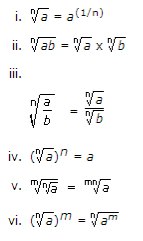Surds & Indices
Surds : which are square root and it cannot be simplified into rational numbers. But indices can be simplified.
For Example: (3 / 9)(1/2) can be written
as 1/ but
but  cannot be written in the form of fraction.
cannot be written in the form of fraction.
Irrational numbers which
contain the radical sign (  ) are called as surds.
) are called as surds.
Note :
1. All surds are irrational numbers.
2. All irrational numbers are not surds.
Indices: Indices refers to the power to which a number is raised. Index is used to show that a number is repeatedly multiplied by itself.
For example: a3 is a number with an index of 3 and base ‘a’. It is called as “a to the power of 3”
IMPORTANT FACTS AND FORMULAE
1. Laws of Indices:

2. Surds:
Let a be rational number and n be a positive integer such that 
Then,  is called a surd of order n.
is called a surd of order n.
3. Laws of Surds:

4. Expressing a number in radical form
Example: l x(m/n) l = 
The exponential form l x(m/n) l is expressed in radical form as 
Important points to Remember
1) Any number raised to the power zero is always equals to one. (Eg: x 0 = 1)
2) Surd  can be simplified
if factor of x is a perfect square.
can be simplified
if factor of x is a perfect square.
3) If denominator in a fraction has any surds, then rationalize the denominator by multiplying both numerator and denominator by a conjugate surd.
4) Every surd is an irrational number, but every irrational number is not a surd.
5) The conjugate of (2 + 7i) is (2 – 7i)
6) Different expressions can be simplified by rationalizing the denominator and eliminating the surd.
Rationalizing the denominator:
To rationalize the denominator  multiply with its conjugate to both numerator and denominator
multiply with its conjugate to both numerator and denominator
Example 1: 
Example 2: 
